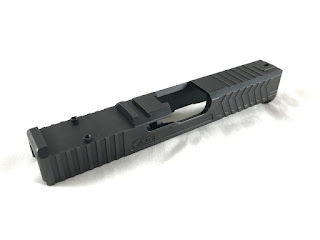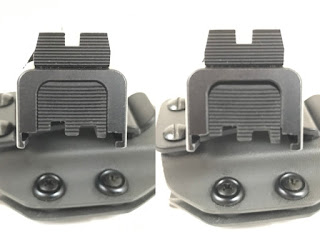Last year I attended Sage Dynamic's 2-Day Vehicle Defense class. Shortly after drooling over some of the other students guns, I decided I wanted a no-compromises gun for training and EDC. As much as I liked my Unity Atom slide, I knew a dedicated milled slide would position the RMR lower and further back on the slide, reclaiming some of the lost sight radius when mounting irons forward of the optic. I also wanted more than five lines of front serrations and a more robust finish. While I've had excellent results from JagerWerks (four slides so far) BattleWerx sprung up on my radar when they introduced their anti-flicker plate for the RMR. A raised boss on the plate mean I don't have to use electrical tape, hot glue, foil shims, or any other other remedies to prevent my RMR dot from flickering if the battery shifts. They only have four slide packages. Battle Slide and three flavors of Gripper. While all are functional, the Battle Slide looks fantastic while doing so. One key difference between the BattleSlide cut and the others is the way the cuts are milled. Instead of a square endmill which leaves perfect 90 degree corners, the BattleSlide is cut with a radiused end mill, leaving a profile more like a table-top ramp. You can see a close-up of the profile below.
 |
| Serrations milled with a radiused bit. |
Another difference is the method in which they secure the RMR to the slide. Most RMR cuts are designed to secure the RMR at the front and rear of the body. Though commonly used, two raised bosses at the front of the pocket are unnecessary since the recoil forces are distributed by the body of the RMR. BattleWerx and a number of other companies instead mill raised indexing posts that are threaded for the RMR screws. This allows the pocket to be cut deeper while also providing more threads for the screws to engage. This allows the BattleWerx RMR cut to be 0.020" deeper than the traditional method. This moves the RMR closer to the boreline, fractionally reduces weight, and compensates for the .010" thickess of a sealing plate. The RMR and sealing plate are easy to align due to the threaded posts as well during installation. A drop of Loctite and firm turn of the allen wrench are all that's needed to lock down the included mounting screws.
The black nitride finish is perfect. While the nitriding is outsourced, the preparation is not. The flats and edges are sanded by hand to ensure no burrs or milling marks. The slide arrived with a new striker channel installed. I completed it with a Blacklist barrel, 10-8 sights, and OEM internals before reuniting it with my frame. Racking the slide, and feeling how smooth it glides over the rails and trigger connector, I decided I would probably never Cerakote my slides again. Cerakote can add more thickness to a treated part than nitride. This was most evident at the breechface and striker plunger hole on some previous slides. The barrel and plunger would hang up slightly until the Cerakote wore away. While Cerakote supposedly provides more corrosion resistance, nitride is tougher and more innately slick. The gun cycles when dirty and bone dry, even with a full sized suppressor.
I've run this gun as my EDC, training, and HD gun. It's sighted in for standard pressure 147 Gold Dots at 15 yards and has run a few thousand runs of Lawman 147 and 115 AE without a single problem. Last fall, I ran it hard along side my CZ P-10C and PWS MK111 at Sage Dynamics Defense in the Home with boring consistency. Recently, I added Agency Arms new 417 compensator and experienced follow-up shot nirvana.
 |
| HD setup. Reliable with stock recoil spring. |
 |
| Gripper slide from BattleWerx (stock photo) |




















































